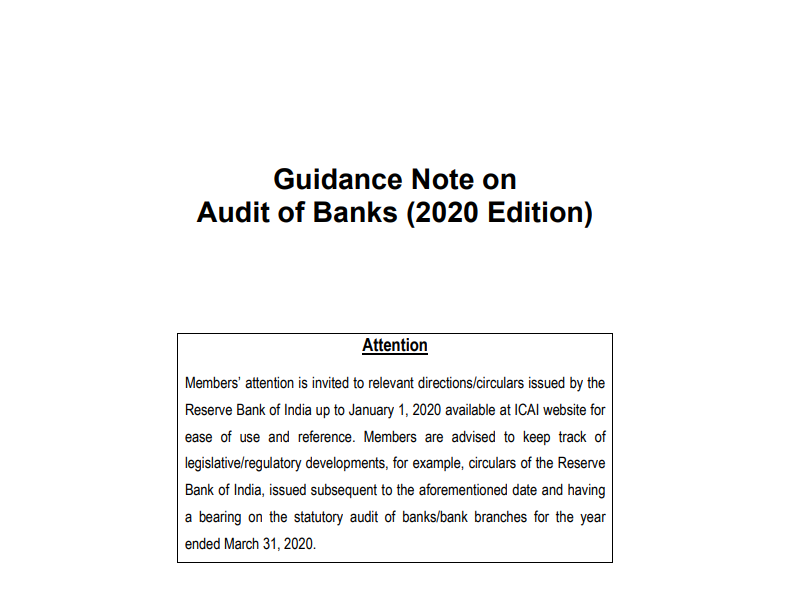Guidance Note on Audit of Banks 2020: ICAI
Table of Contents
Section A – Statutory Central Audit
Section A of guidance note on audit of banks 2020 covers the personal banking and operations department.
1. Personal Banking and Operations Department
Introduction
1.01 The area of operation/function of the Personal Banking and Operations Department is typically confined to the Resource Mobilization, i.e., source of funds (for the bank) in the form of CASA Deposits, Term Deposits, and customer service and operations. The department is responsible for the monitoring of the deposit portion which is a major contributor for the bank as a resource of funds.
1.02 In today’s’ new age banking, there are various innovative products that are launched by every bank which has its own unique characteristics and customization based on the need for funds and customer portfolio of the bank. For example, the bank may have deposit products as well as products/services linked with the categorisation of customers based on predefined criteria offering privileged banking services to a certain section of customers. In the era of liberalization of the rate of interest, every bank is expected to be proactive in terms of decision making for the rate of interest. Further, the banks do have specified policies w.r.t. bulk deposits and the bank may offer special rates on such deposits on a need-based basis.
Preparation / Planning
1.03 The Statutory Central Auditor (SCA) should obtain a deposit policy of the bank and rules and regulations related to deposits as framed by the bank. Further, the auditor should get himself acquainted with the various deposit products of the bank along with rules related thereto. The bank may have various methodologies adopted for interest payment wherein the deposits can be non-cumulative, cumulative deposits and in certain cases, a bank may launch schemes wherein there is a bullet payment of interest at the end of the tenure of deposits without compounding of interest.
Conduct / Execution
1.04 Verify the application of rate of interest vis-à-vis interest table to every product of deposits by taking sample accounts of each type of deposit product including instances of premature withdrawal of deposits, retrospective renewal of deposits
- Verify whether the accounting effects of interest payable in the form of interest accrued but not due and interest accrued and due are correctly given and compliance of TDS thereon.
- Verify the compliance of internal circulars of the bank in terms of categorization of customers and the application of the said terms in the master data of such deposit holders.
- Verify the compliance with the rules and regulations formulated by the bank related to the deposit products based on sample check.
- Verify the complaints lodged w.r.t. the customer services and contingent liability/liability arising thereon.
- Verify the special rate deposits (those deposits wherein rate of interest is deviated as compared to the interest table) as regards the eligibility and approval of the same as per the internal policy of the bank.
Reporting / Conclusion
1.05 Check whether the appropriate presentation of deposits is made in financials of the bank with reference to the type of product, interest accrued thereon and also verify the requirement for disclosure of contingent liability, if any, arising out of consumer court and other cases, related with deposits. Based on the audit issues, appropriate reporting of adversities observed in the Deposit section and customer services.
1.06 Readers may note that for the reference and benefit of the members various illustrative formats for Auditor’s Report, Engagement Letter, Management Representation Letter, Exception Reports in CBS, Checklist for Capital Adequacy, and Checklist for the verification of the aspects of the Treasury/Investments are given in the appendices of Section A (Available on ICAI website) of the Guidance Note as follows:
Appendix I – Illustrative Format of Report of the Auditor of a Nationalised Bank Independent Auditor’s Report
Appendix II – Illustrative Format of Report of the Auditor on the Standalone Financial Statements of Banking Company
Appendix III – Illustrative Format of Engagement Letter in case of a Nationalised Bank
Appendix IV – Illustrative Format of Engagement Letter to be sent to the Appointing Authority of the Banking Company
Appendix V – Illustrative Format of Engagement Letter to be sent to the Appointing Authority of the Banking Company (Separate only for Internal Financial Control u/s 143(3)(i) of Companies Act, 2013)
Appendix VI – Illustrative Format of Management Representation Letter to be obtained from Bank Management in case of Statutory Central Audit
Appendix VII – Illustrative Format of Management Representation Letter to be obtained from Bank Management in connection with the Limited Review
Appendix VIII – Illustrative List of Special Purpose / Exception Reports in CBS
Appendix IX – Illustrative Audit Checklist for Capital Adequacy
Appendix X – Illustrative Checklist for the Verification of the Aspects of the Treasury/Investments of the Bank in Statutory Audit
2. Retail Banking and Marketing Department
Introduction & Bank’s process
2.01 The banks generally provide various retail advances namely:
- Home loans and loans against property
- Vehicle/Automobile loans
- Personal loan
- Consumer durable loans
- Credit cards
- Microfinance loans
- Jewel loans
2.02 Generally, loans are either sourced through direct selling agents or through bank’s own branches. The bank has a credit policy that defines process to be followed for sanction and disbursement of loan and the various documents required. The sanction for retail loans and management of retail loans cannot be outsourced.
2.03 Recently, the Reserve Bank of India (RBI) has prohibited banks from deploying direct selling agents (DSAs) to sell retail loans and verifying borrowers’ documents. KYC procedures, involving verifying borrowers’ original documents should be performed by bank officials and cannot be outsourced.
2.04 Generally, the credit assessment process is not as detailed as followed in case of corporate loans. The bank generally collects the following documents:
- Completely filled Loan Application Form with customers’ signature.
- Income proof like Salary slip, financial statements, Income tax returns, Bank statement.
- Photograph.
- Business continuity proof. (e.g. Form D of Maharastra Shops and Establishment Act, Any other govt. certificate for doing business).
- Residence proof.
- Identification proof.
- Contact Point – Mobile No of applicants is mandatory.
- Age proof.
- PAN Card.
Credit Due Diligence for Retail Financing
2.05 Credit due diligence for retail financing is different from the wholesale financing since the quantum of loan and the complexity of transaction is different. Retail finance credit due diligence is parameterized / score card-driven wherein if the borrower fits into a pre-defined credit matrix/parameters and gets a score which is above the threshold, the loan is approved/sanctioned. The scorecard parameter would be suitably deliberated and considered based on historical experience and keeping in view the dynamic environment like minimum income criteria, employment details, age, telephone, etc. Once the score is generated the bank would also run the CIBIL score and if CIBIL score is above specific score than the bank considers for further sanction. The scorecard based approved portfolio is closely monitored at a regular frequency and the parameters are suitably modified based on the portfolio’s performance.
Download the copy:

 ConsultEase Administrator
ConsultEase Administrator
Consultant
Faridabad, India
As a Consultease Administrator, I'm responsible for the smooth administration of our portal. Reach out to me in case you need help.







